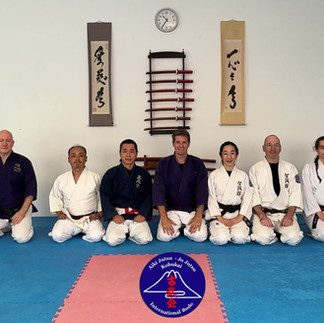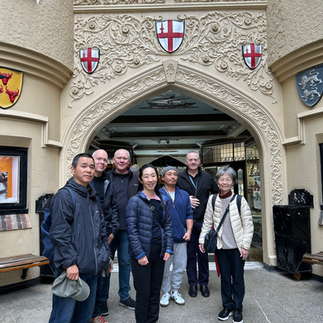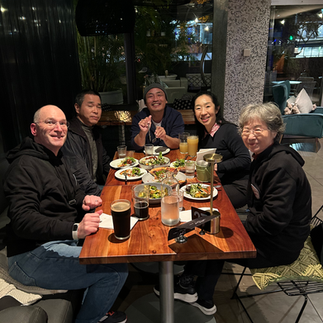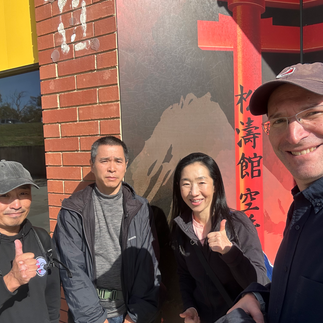Australia Perth Dojo Tour – Final Reflections
- Yoshie Sugai

- Jul 26, 2025
- 3 min read
During this Perth Dojo Tour, we had the opportunity to visit seven dojos and engage in training with many instructors and students. Each dojo had its own unique character and philosophy, and throughout the journey, we could deeply feel the respect and passion each one held for budo. More than simply learning techniques, this tour reaffirmed for us the true essence of budo as a form of education.
日本語はこちら
One of the most memorable aspects of the trip was seeing how instructors from different styles came together to learn from one another and grow together. At the yudansha (black belt) keiko at Gyokushinkan, several teachers gathered to carefully analyze basic techniques and exchange ideas. This humble and sincere approach to learning was deeply inspiring, and we felt strongly that it is something we, as instructors in Japan, should also emulate.
We also gained profound insights into the evolution and exploration of jojutsu (short staff techniques). Through the instruction of Steve Sensei and Darren Sensei from Kobukai International Budo, we saw how the jo techniques passed down from Kumono Sensei have continued to evolve and are being practiced in a systematic way. There were many discoveries through the structure of techniques, control of force, and body mechanics that will significantly influence our own teaching going forward.
At West Coast Aikido, led by Ross Sensei, we saw a shining example of a dojo serving as a place to nurture both the spirit and virtue of budo. The dojo, supported by the entire family and rooted in the local community as a center of education, truly embodied what a budo dojo should be. It was a rare and outstanding initiative—something not often seen even in Japan.
At Self Defense Central Dojo, we experienced a highly refined training method in which students responded to unseen attacks using only visual cues from the instructor. This helped cultivate the ability to “feel and move” rather than think, teaching us the importance of reflexive, embodied response.
We are always deeply impressed and grateful for the sincere attitude and deep thinking of Murat Sensei, head of Yamato International Aikido, a sister dojo of Chiseikan. Thanks to him, we have had the privilege of meeting so many budoka in Perth. His warm-hearted dedication to the growth of his students is truly remarkable and continues to inspire us. His techniques are consistently graceful and efficient, with no wasted movement. Each time we see him move, we are impressed anew and learn something valuable.
I would also like to express my gratitude to Daniel-sensei and his students, who joined me from the first day for sightseeing in Perth, lunch, and many training sessions. The earnest expressions of the students—who listened intently to my words and did their utmost to apply techniques without causing me injury—deeply conveyed their sincere attitude toward learning the "true essence of budo." I am convinced that this is a direct result of Daniel-sensei’s consistent and dedicated instruction. I was especially moved by the way a senior practitioner with 50 years of budo experience listened to my words with such enthusiasm.
Across all the dojos we visited, one thing stood out in common: the flexibility, curiosity, and sincerity of the Australian instructors. Their constant effort to reflect on and improve their own methods is a shining example of what it means to be a true budoka. There is so much we, too, can learn from them.
We would also like to extend our heartfelt thanks to Murat Sensei for the airport pickups and to Steve Sensei, who not only repeatedly drove us between dojos and accommodations, but also took on the responsibility of planning the entire schedule. Words cannot express how grateful we are, especially to Steve Sensei. This dojo tour could not have happened without his support, and both Ezawa Sensei and Hide-san repeatedly shared how deeply meaningful the journey had been for them.
Lastly, we offer our sincere gratitude to all the instructors who have supported the idea of building relationships among dojos that continue to learn and grow together, in order to pass on the true essence of budo and the spirit of Mochizuki Aikido to the next generation. If this circle of like-minded instructors—the great harmony of Yamato—can continue to expand, and if together we can nurture future leaders who guide society in a better direction, then surely we will be contributing to the very ideal that so many budo founders envisioned.
To all the instructors and students at the dojos we visited, and to our fellow travelers on this journey—thank you from the bottom of our hearts for making this such a meaningful and unforgettable experience.




































Comments